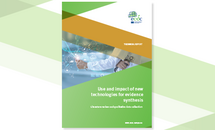Use and impact of new technologies for evidence synthesis - Literature review and qualitative data collection
This report studies the implementation and impact of new technologies to support the development of evidence syntheses.
Executive Summary
This report studies the implementation and impact of new technologies to support the development of evidence syntheses and aimed to answer the following research questions:
- What types of automated technologies are available and have been used for evidence synthesis, and how have these been used?
- At what stage in the evidence synthesis pathway have these automated technologies been used (e.g.literature searching, screening, data extraction)?
- What are the experiences and lessons learned from using automated technologies in evidence synthesis?
- What is the impact of using automated technology for evidence synthesis?
- What are the needs of European Union (EU)/European Economic Area (EEA) competent health authorities in conducting technology-assisted evidence syntheses and how can these gaps be filled?
To answer these questions, we conducted a systematic review of the academic and grey literature on how new technologies have been used to automate or semi-automate parts of the evidence synthesis, and the experience of individuals and organisations that have used this technology. We searched Ovid MEDLINE, Embase, Cochrane Library, CORDIS and the websites of key public health authorities in EU/EEA countries, ECDC international partners and major evidence synthesis providers. Articles were screened against a set of inclusion/exclusion criteria and relevant ones were taken forward to data extraction. In total, we included 157 articles in this review.
We also conducted a mapping exercise in which we collected qualitative data around new technologies for evidence synthesis in the form of focus groups (n= 5, total of 46 participants), interviews (n= 3) and an online survey (n= 9). The aim of this was to map the current use of automated technologies for evidence synthesis by EU/EEA public health bodies, as well as to map the experiences of using these types of tools that could not be identified by reviewing literature alone. Participants included people that had experience using new technologies for evidence synthesis, organisations that regularly conduct systematic reviews and are active in initiatives around the use of technologies, representatives from public health competent authorities in EU/EEA Member States, representatives from ECDC, evidence synthesis experts and others working in the area of public health and infectious diseases.
Download





